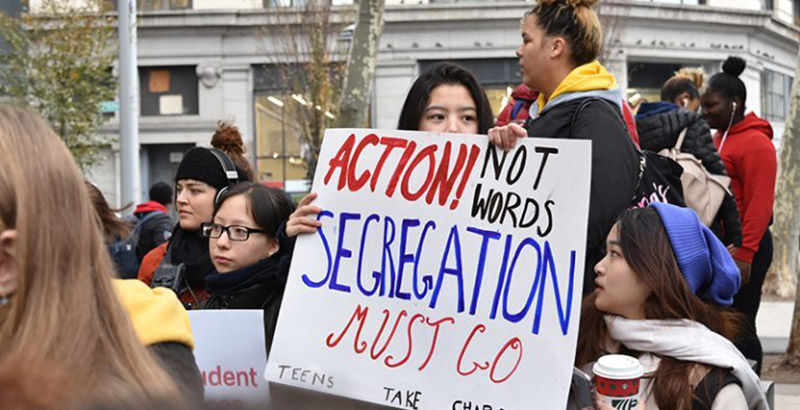Adams: When NYC Honors Classes, Gifted-&-Talented and Tracking Started to Disappear, So Did Black Kids from the City’s Top High Schools. Coincidence?

Get stories like these delivered straight to your inbox. Sign up for The 74 Newsletter
When my African-American husband entered the freshman class of Stuyvesant, New York City’s top specialized high school, in 1981, there were more than 200 Black students enrolled. A few miles away, at Brooklyn Tech, two-thirds of the students were Black and Latino.
In 2017, when our older son graduated from Stuy, and 2018, when our younger one started, the number of Black students there was under 40. Across all eight high schools that use the Specialized High School Admissions Test, only 3.6 percent of admission offers in 2021 went to Black students (though they make up 26 percent of the total public school system), despite the availability of a city-run summer prep program.
African-American enrollment at Stuyvesant peaked in 1975. This was three years after the admissions test was enshrined into state law as the sole criterion.
So where have all the Black students gone?
As the New York Times recently pointed out, “Decades ago, when crime and socioeconomic conditions were far graver than they are today, Black and Latino teenagers passed the examination in great numbers.”
And while the contents of the test have been tweaked a few times since then, on each occasion the stated goal was to enable more Black and Latino students to qualify for admission. In addition, a Discovery program was put in to help those who scored just a few points short of the qualifying cut-offs to attend summer prep courses and earn a second chance at admission. So what happened? Why didn’t anything work?
The writer of this editorial recalls that:
Back in the early to mid-1960s, I was part of a wave of young Black and Latino shock troops coming out of poverty, public housing and tenements whose purpose was to obliterate any and all educational obstacles. We excelled at school and test-taking. We kicked down educational barriers wherever they existed, hoping that there would be a stream of Black and Latino students who would follow our example and slip through the cracks our assault on the system had created. We took the specialized high school entrance exam and passed. We gained admission to Stuyvesant, Bronx Science and Brooklyn Tech, and for years, the number of Black and Latino students attending the elite schools increased. When people talked about integration in those times, WE were integration. This group of “uppity” young Black/Latino young men and women was able to successfully compete anywhere at any time with anyone. Then something happened. Our young people seemed not so uppity and often not as ready to compete with others. Numbers that had risen, whether test scores or admissions to prestigious schools, leveled off and then began to decline. What happened?
What seems to have happened is multiple policies that were supposed to encourage the longed-for integration of New York City public schools. As the Times elaborates: To understand this decline involves a trek back through decades of policy choices, as city officials, pushed by an anti-tracking movement, rolled back accelerated and honors programs and tried to reform gifted programs, particularly in nonwhite districts.
In an attempt to shrink the achievement gap, New York, along with many other American cities, moved to get rid of tracking — the practice of sorting students by ability into homogeneous classrooms. Though research continues to be mixed on the pros and cons of heterogeneous ability grouping, in New York City, the view prevailed that getting rid of accelerated and honors programs in kindergarten through eighth grade would lead to higher — or, at least, equal — achievement for all in high school.
What happened in actuality was the opposite: In wealthy districts, when programs for high achievers were cut, parents moved out of the city, transferred their children to private schools or hired tutors from outside the classroom. In poorer, often also nonwhite, districts, high-achieving students were left with no such options. No more honors programs meant a curriculum well below what some students were capable of. It meant fewer complex texts to analyze and no algebra in middle school. Mastery of both is vital to success on the high school admissions test — but students were no longer being taught what they needed to know to pass it.
Plus, where, previously, a majority non-white school with a terrific academic program might have attracted some wealthier and whiter students (a phenomenon we are currently seeing with some NYC charter schools), the lower-performing these schools got, the fewer affluent families of any ethnicity would even consider attending them. This led to even more segregation, both racial and economic — not less, as had been predicted.
The ultimate consequence to losing these programs was espoused by city public advocate and current gubernatorial candidate Jumaane Williams, himself a Brooklyn Tech grad. In 2020, he joined City Council members Robert Cornegy, Ben Kallos and Justin Brannan to propose legislation that would require every public middle school to provide free specialized high school admissions test prep. As Williams wrote in the Daily News, “The most clear failure has been establishing an accessible pipeline. In the past, gifted-and-talented programs in middle schools have been a reliable pathway.”
A key bit of irony is that, prior to 2008, when elementary schools were allowed to select students for admission to neighborhood G&T programs using their own criteria, those programs were more racially and socio-economically diverse than they became after the process was standardized under Mayor Michael Bloomberg. Once applicants were all required to take the same test and earn the same qualifying cut-off score, G&T schools ended up admitting fewer diverse students. And in neighborhoods where very few children qualified under the new standardized scoring system, G&T programs were shuttered.
Under Mayor Bill De Blasio, even more G&T programs were eliminated, this time not due to lack of applicants or qualifiers, but in the interest of equality — another name for the detracking movement. In the same vein, middle schools that previously could select students for their advanced programs based on grades and test scores dropped the practice altogether. In both cases, that spelled the end of placing some students on an accelerated academic track.
In 2021, de Blasio announced that all elementary school gifted and talented programs and honors programs in middle schools would be eliminated, once schools were no longer allowed to look at grades and test scores in order to place students into advanced classes.
It was the original push to end tracking that brought us to the current state of only a handful of minority students earning entry into the specialized high schools. As of now, we are still waiting for word on what will happen to K-8 G&T schools and whether they will also no longer be allowed to offer accelerated programming for advanced learners. Considering the results of the last 40-plus years, should we really keep doubling down on an approach that has been demonstrated to hurt more than it helps?
Alina Adams is a New York Times best-selling romance and mystery writer, the author of Getting Into NYC Kindergarten and Getting Into NYC High School, a blogger at New York School Talk and mother of three. She believes you can’t have true school choice until all parents know all their school choices — and how to get them. Visit her website, www.NYCSchoolSecrets.com.
Get stories like these delivered straight to your inbox. Sign up for The 74 Newsletter


